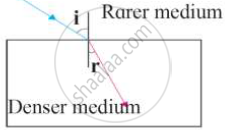Advertisements
Advertisements
Question
Light of a single colour is passed through a liquid having a piece of glass suspended in it. On changing the temperature of liquid, at a particular temperature, the glass piece is not seen.
Why is the light of a single colour used ?
Solution
Light of a single colour is used because the refractive index of a medium (glass or liquid) is different for the light of different colours.
APPEARS IN
RELATED QUESTIONS
When rays of light are incident on a glass slab then the incident ray and emergent ray are _________ each other.
- perpendicular
- parallel
- opposite
- concurrent
Explain the term absolute refractive index of a medium and write an expression to relate it with the speed of light in vacuum.
What do you understand by the statement the refractive index of glass is 1.5 for white light?
Observe the figure and write accurate conclusion regarding refraction of light.

Draw an í- `delta` graph for a mono chromatic raY through a glass prism of a plane and mark
(i) `delta` m, the angle of mínimum devíation
(íí) Any two values of i for which value of `delta` ís same.
Rewrite the following statement by selecting the correct option:
If a ray of light strikes a glass slab at an angle of 600 with the surface of the slab, the angle of incidence must be __________________.
Does the depth of a tank of water appear to change or remain the same when viewed normally from above?
What is the refractive index of water
The refractive index of air with respect to glass is defined: as gµa = sin i/sin r
If r = 90°, what is the corresponding angle i called?
The diagram shows the path of a ray of light through a rectangular glass block placed in a liquid of uniform density.

(a) Does the light speed up or slow down in the glass,
(b) Give the reason for your answer.
